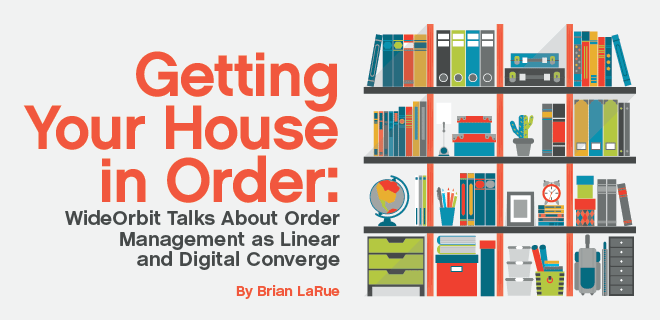
More than ever, media companies offering video campaigns straddle both sides of the traditional/digital divide. In some cases, we see ad budgets shifting from TV to digital. In others, we see the opposite pattern. While that’s opened up all kinds of new opportunities for both broadcasters and publishers, the lack of common systems and metrics makes it convoluted and time-consuming to manage their sales workflow. They also have to figure out how to measure results and report back to clients—what’s GRP even mean when you’re used to impressions?
As digital and traditional media converge, publishers and broadcasters need to think deeply about cross-channel order management. To help us understand what that might mean, we got on the phone with David Christopher-Morris, WideOrbit’s VP Product, WO Digital Hub, North America; and Will Offeman, WideOrbit’s EVP, Engineering. David came to WideOrbit through that company’s acquisition of Fivia, whose digital order management system has been rebranded as WO Digital Hub. Will oversees product and development on the company’s broadcast side, for WO Traffic and WO Network.
AdMonsters Staff Writer Brian LaRue and Editorial Director Gavin Dunaway started by asking about David’s observation that many media companies try to run their order management systems simply by manually entering data into separate systems and linking spreadsheets.
BRIAN LaRUE: What’s holding publishers back from bringing all their selling processes into a more centralized system?
DAVID CHRISTOPHER-MORRIS: Historically, media types across broadcast and digital have spoken different languages, so there’s been a challenge of negotiating metrics. With audience measurement, there needs to be some kind of negotiable or common currency. Sellers shouldn’t have to feel like they’re stuck waiting for new solutions. They can take the initiative by looking at what they have and can control today, which is their technology stack. Fundamental and central to that is having a system of record, their order management system, that integrates with their other systems.
WILL OFFEMAN: To sell both digital and traditional, media companies used to set up separate teams, with separate software. Publishers and agencies did the same thing. The industry trend now is to bring all that together. Currency is one major concern, but also the systems and tools have to work across the two kinds of media.
BL: What’s top of mind for your publisher/broadcaster clients right now as far as order management is concerned, and what are you doing to address their concerns?
 DCM: The industry is moving toward an audience view. The buy side is using big data to target their audience effectively. The sell side needs to do the same thing. The ability to fluidly move across media types is important. The number one goal is to unite those ad transactions into a single system.
DCM: The industry is moving toward an audience view. The buy side is using big data to target their audience effectively. The sell side needs to do the same thing. The ability to fluidly move across media types is important. The number one goal is to unite those ad transactions into a single system.
WO: Our clients are always concerned about pricing and planning tools. One of the things they’re looking at is fluidity, the ability to move guaranteed CPM impressions across digital and traditional. Sellers want to negotiate deals in the upfronts, and by providing the metrics back to the buy side, they have more control over where they can deliver.
GAVIN DUNAWAY: Who do you think is really driving the push to convergence, the buy side or the sell side?
WO: It’s coming from both sides. In broadcast TV, the main strength is reach. They have lots of eyeballs, slightly better controls on frequency. On the digital side, there’s an audience and a lot of video, but premium advertisers don’t want their ads showing up in questionable media outlets. The convergence lets sellers move the delivery based on where the audience is, and delivers as many unique eyeballs as possible to the buy side.
We have this mantra: Always think about your customer’s customer. Media companies really need to understand advertisers, even when they’re selling directly to agencies.
BL: Traditional broadcast has influenced the way digital is transacted. What’s your assessment of where we are in the process of bringing the two sides together?
WO: Language is important. We often talk about traditional versus digital, but I like to talk about unicast versus broadcast. At WideOrbit, we use the term omnicast–a merger of unicast and broadcast, where you’re targeting a huge audience, and you can cherry-pick profile information.
GD: What advantages does WideOrbit have from its history in television and radio, in creating an all-encompassing platform?
 WO: WideOrbit’s been doing this for 17 years. Our customers have been broadcasters, but the questions we help them solve are important for both traditional and digital media. It’s a matter of: How can we optimize the pricing and inventory utilization for and high-demand content? We’re not in the business of remanant, but of monetizing content people want, with a great audience and brand recognition. That’s why premium content owners are adopting our solutions.
WO: WideOrbit’s been doing this for 17 years. Our customers have been broadcasters, but the questions we help them solve are important for both traditional and digital media. It’s a matter of: How can we optimize the pricing and inventory utilization for and high-demand content? We’re not in the business of remanant, but of monetizing content people want, with a great audience and brand recognition. That’s why premium content owners are adopting our solutions.
BL: Beyond the technical systems, what needs to be done to make different business cultures or perspectives talk to each other effectively?
DCM: We surveyed thousands of ad buyers in April, and 93% said they think it’s important to buy digital video and linear TV together. That’s a huge number. Now we are building the systems to move toward that goal. Digital marketers are accustomed to using very detailed metrics and audience parameters. We need an industry agreement on standards so we can have consistent audience measurement across media types.
GD: The MRC has been talking forever about doing a GRP standard. Do you think that’s an answer?
WO: At the end of the day, advertisers want to know how many times they’ve reached this person across TV, radio, outdoor and everything else. It’s not just about GRP or impressions, but about how we provide the best experience to the consumer so they’re aligned with the advertiser.
BL: Where are you focused on a technical level in making these processes more efficient across platforms?
DCM: We’re now developing an integration between WO Digital Hub, our digital order management system; and WO Network, which is an order management system for cable networks. It will give media companies the ability to manage digital campaigns with linear metrics. By having both systems talking the same language, it is possible to have that information flow back and forth across media types.
WO: Technology typically lags a little bit behind real world business processes. Media companies can do are doing cross-channel sales today, but they’re doing it through Excel.
GD: But what if I love my Excel spreadsheet?
WO: We always get pushback, because Excel can do anything. But we do believe that having consistency between tools and entering and presenting data will help. Everyone does things slightly differently. Things don’t typically become consistent until the software leads. I think we can help there.
BL: So what can publishers do on their own time to make order management more efficient and effective?
DCM: It’s not just what they can do apart from vendor partners. People hopefully are working with a vendor that is a partner, that listens and works to take their businesses forward.
WO: Publishers shouldn’t take the stance of: “Here’s what I have to sell. Take it or leave it.” They should reach out to the buying community to understand how the buy side is leveraging information and optimizing campaigns. Media providers should share that knowledge with their technology partners so they can develop systems that fit both sides’ current and future needs.
GD: How you appeal to the digital publishers looking to get in on the OTT opportunity?
WO: WideOrbit’s heritage is in linear media. We invested in four companies over the last two years for digital order management; digital audio on demand; podcasting; and decisioning for display. While a lot of OTTs don’t have huge demand yet, they know they need to move into cross-format audio and video. It all comes back to listening to what customers are asking for, and then building the solutions.